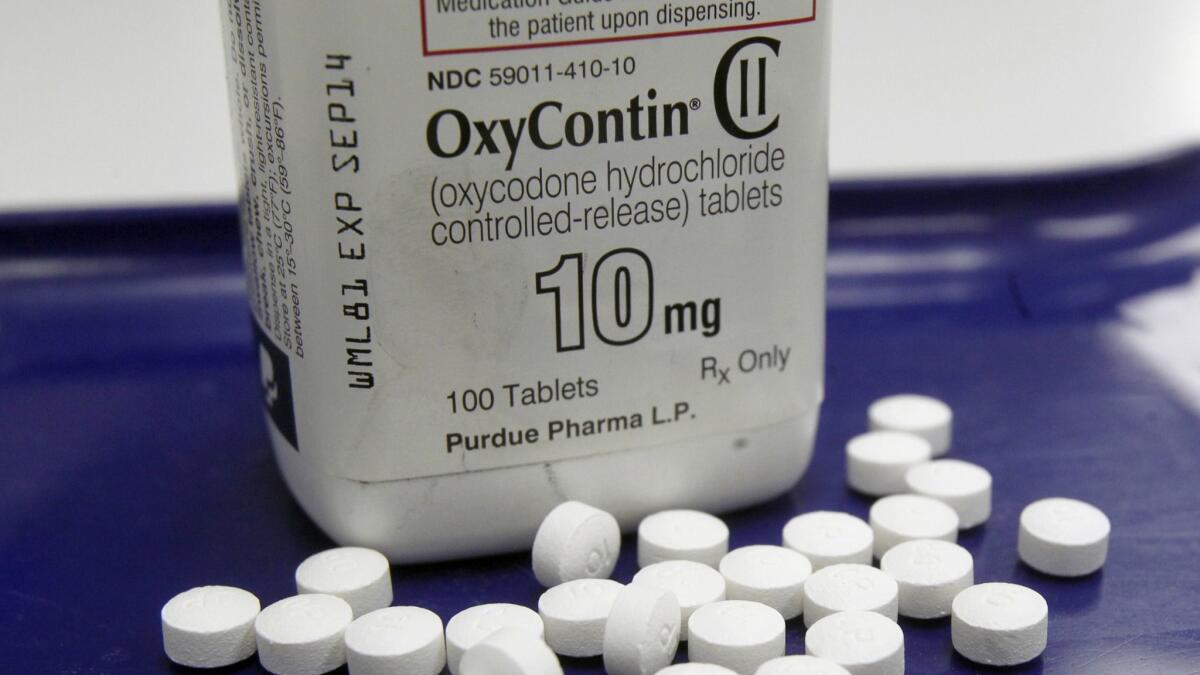Column: No, Medicaid expansion did not worsen the opioid crisis — but it’s crucial for fixing the problem

- Share via
One of the most popular partisan attacks on Medicaid is the claim that the program’s expansion under the Affordable Care Act exacerbated the opioid crisis in America. —
You’ll find this claim retailed on right-wing websites all across the internet. It’s been energetically marketed by Sen. Ron Johnson, R-Wisc., who paints a picture of an army of Medicaid patients using their government-provided ID cards to obtain prescription opioids for free, then turning around and selling the drugs at a terrific markup.
Johnson’s claim has been widely debunked, as we’ve reported before. But a new paper from a group of researchers at Johns Hopkins emphasizes another aspect of the matter generally overlooked or minimized by Johnson and his acolytes: Medicaid, including Medicaid expansion, is crucial for treating the opioid epidemic.
We need to have a more serious conversation about what we need to do to make sure that people get the treatment they need when they need it.
— Brendan Saloner, Johns Hopkins University
The research “rebuts the idea that Medicaid expansion was this pathway for a big increase in people filling prescriptions for opioid pain medication,” Brendan Saloner, the paper’s lead author, told me. “But there was a big increase in people getting addiction treatment where they were prescribed buprenorphine-naloxone.”
That drug combination, typically marketed as Suboxone, is an established treatment for opioid addiction because it reduces craving and withdrawal symptoms. But it’s available only through a doctor’s prescription and carries a list price of nearly $200 per month.
“To get into a doctor’s office generally takes some financial resources,” Saloner observes. That’s where Medicaid comes in.
Saloner’s paper, which was published last week in the online open-access publication of the Journal of the American Medical Assn., was based on the records of nearly 12 million patients who filled prescriptions for opioid pain medications from 2010 through 2015 in the Medicaid expansion states of California, Maryland and Washington, and the non-expansion states of Florida and Georgia.
Some context is useful. As we reported before, while it’s true as Johnson says that drug overdose deaths have risen at an alarming rate since Medicaid expansion began, they also were rising at an alarming rate before Medicaid expansion began. The trend began in the 1990s, when doctors began prescribing opioids such as oxycodone in the belief that they would effectively relieve chronic pain with minimal risk of addiction.
From then until about 2010, prescription opioids were the cause of most opioid overdose deaths. But then heroin took over — until about 2014, when the chief culprit became fentanyl. The most recent statistics from the Centers for Disease Control and Prevention are that nearly 200 Americans died every day from drug overdoses in 2016; two-thirds involve a prescription or illicit opioid. CDC said the OD death rate from illicit synthetic opioids, chiefly fentanyl, had doubled over the previous year, while the rate for heroin-related ODs had increased by 19.5% and the rate from prescription opioids increased by 10.6%. Medicaid doesn’t cover heroin or fentanyl.
Johnson’s assertion about the role of Medicaid expansion appears to be based on two factors: A flawed interpretation of the data, and an ideological impulse to attack Medicaid expansion. Johnson focused on an increase in opioid deaths in expansion states after the expansion in 2014, but massaged his presentation to obscure that the increase in opioid-related hospitalizations followed the same trend in expansion and non-expansion states. To the extent it might have been a bit higher in expansion states, that was because many states at the epicenter of the crisis had opted to expand — the hospitalization rates in expansion states were higher as early as 2011, three years before expansion began.
Nevertheless, Johnson took his fabricated ball and ran with it. “If Medicaid is helping to drive the epidemic, it stands to reason that expanding the program — particularly to people most susceptible to abuse — could worsen the problem,” the GOP majority on his Homeland Security Committee wrote in a January report. The report skated over the fact that opioid prescriptions already had leveled off and illegal drugs had become the problem.
It’s true that the number of opioid prescriptions Medicaid paid for increased after 2014, and at a higher rate in expansion states, but coverage by other payers such as Medicare and private insurers as well as by cash leveled off or fell, according to the Johns Hopkins study.
Overall prescriptions did not increase after expansion. “We would call it a crowd-out or cost-shifting story,” Saloner says. “It’s the same number of people, but they’re using a different source of payment.”
The most important aspect of the story, he adds, is that more patients have access to buprenorphine-naloxone. “One of the ways Medicaid expansion could be important is in giving people more choices” for treatment, he says, including getting treatment from a doctor if that’s what they desire rather than providing them only with a medication-free treatment program or a methadone maintenance program.”
Saloner says the discussion of whether Medicaid helped or hurt in the opioid crisis is a “swirling political dialogue” that obscures the real task ahead to quell the crisis.
“We need to have a more serious conversation about what we need to do to make sure that people get the treatment they need when they need it,” he says. “There’s a lot of hard work that has to get done once you get people into Medicaid. It’s a necessary condition, but not sufficient.”
Keep up to date with Michael Hiltzik. Follow @hiltzikm on Twitter, see his Facebook page, or email [email protected].
Return to Michael Hiltzik’s blog.







